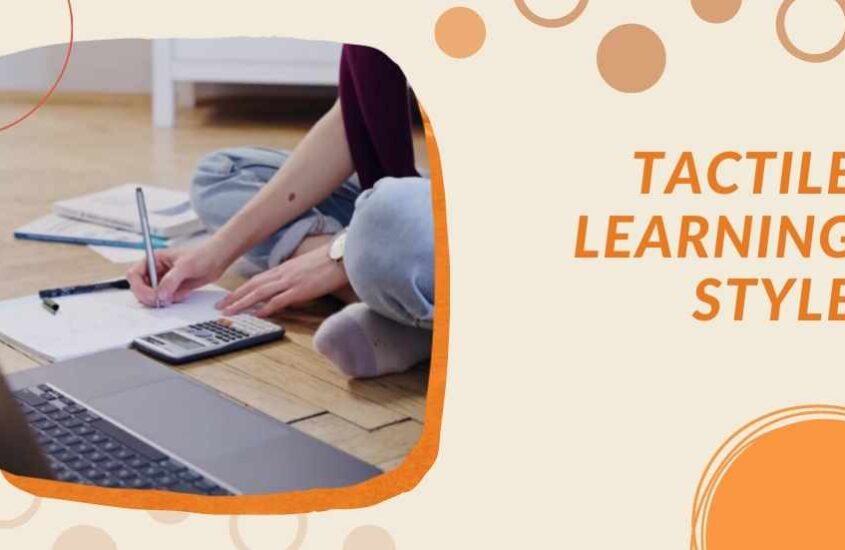Tactile Learning Style: Engaging Hands-On Education for Enhanced Comprehension

Tactile learning style, also known as kinesthetic learning, involves learning through physical interaction and hands-on experiences. Tactile learners prefer touching, feeling, and manipulating objects to better understand and retain information. They excel in subjects that allow for active engagement and benefit from interactive teaching methods. In both academics and careers, tactile learners thrive when they can utilize their sense of touch and physical dexterity. Incorporating hands-on activities and interactive exercises is key to facilitating their learning process.
What is hands-on education?
Hands-on education, also known as experiential learning, refers to an educational approach that emphasizes active participation and direct interaction with materials, objects, or real-life situations. It involves providing learners with opportunities to engage in physical activities, experiments, simulations, or practical experiences to deepen their understanding of concepts and develop practical skills.
Hands-on education goes beyond traditional classroom lectures and textbook-based learning. It encourages students to explore, experiment, and problem-solve through active engagement. Instead of passively receiving information, learners actively manipulate objects, conduct experiments, and apply their knowledge in real-world scenarios.
This approach has several benefits. First, it fosters a deeper level of understanding as students can directly experience the concepts they are learning. By physically engaging with materials or performing tasks, they gain a more tangible and concrete understanding of abstract ideas. This hands-on approach helps bridge the gap between theory and practice, enhancing comprehension and retention.
Second, hands-on education promotes critical thinking and problem-solving skills. By actively engaging with challenges and finding solutions, students develop their analytical and creative abilities. They learn to apply their knowledge to real-life situations, adapt to different scenarios, and think independently.
Furthermore, hands-on education enhances motivation and engagement. The interactive nature of this approach sparks curiosity, stimulates curiosity, and fosters a sense of ownership over the learning process. Students become active participants, which can lead to increased enthusiasm, intrinsic motivation, and a deeper sense of satisfaction in their educational journey.
Hands-on education is particularly effective
Hands-on education is particularly effective in subjects like science, technology, engineering, arts, and mathematics (STEAM), where practical application and experimentation are crucial. However, it can be applied across various disciplines and grade levels. Whether it involves conducting science experiments, creating artwork, building models, or participating in field trips, hands-on education can be tailored to suit different subjects and learning objectives.
Educators play a vital role in facilitating hands-on learning experiences. They design and provide materials, resources, and activities that encourage active participation. They also guide and support students during the process, helping them reflect on their experiences, draw connections, and derive meaning from their hands-on interactions.
Overall, hands-on education promotes a holistic and immersive learning experience, allowing students to develop a wide range of skills while fostering a deeper understanding of the subject matter. By combining theory with practice, it prepares learners for real-world challenges and equips them with the knowledge and skills necessary for success in their academic and professional lives.
How does hands-on learning enhance comprehension?
Hands-on learning enhances comprehension by providing learners with direct experiences and tangible interactions with the subject matter. Through active engagement and manipulation of materials, students can see, touch, and explore concepts, making them more concrete and understandable. This hands-on approach bridges the gap between theory and practice, leading to deeper understanding and improved retention of information.
How can educators incorporate hands-on activities in the curriculum?
Incorporating hands-on activities in the curriculum allows educators to create an engaging and interactive learning experience for students. By incorporating experimentation and lab work in science and STEM subjects, students can actively manipulate materials, collect data, and draw conclusions. Field trips to museums, historical sites, and nature reserves provide students with real-world experiences that complement classroom learning. Additionally, educators can introduce hands-on activities through project-based learning, where students work on long-term projects that require research, problem-solving, and creative thinking. This approach encourages collaboration, critical thinking, and the application of knowledge in practical situations. Technology can also play a role in hands-on activities, with the use of interactive simulations, virtual reality, and online tools that allow students to explore concepts and engage in virtual experiments. By incorporating hands-on activities in the curriculum, educators promote deeper understanding, active participation, and the development of essential skills more information Smooth Precision Pens.
Understanding Hands-On Education
Hands-on education refers to an instructional approach that emphasizes active engagement and practical experiences for students. It involves providing opportunities for learners to directly interact with materials, objects, and real-world scenarios, rather than solely relying on passive learning through lectures or reading.
In hands-on education, students become active participants in their learning process. They engage in activities that require them to manipulate objects, conduct experiments, solve problems, collaborate with peers, and apply theoretical knowledge in practical contexts. This approach aims to enhance understanding, critical thinking, problem-solving skills, and retention of information.
Hands-on education can be implemented across various subjects and grade levels. For example, in science, students may conduct experiments in laboratories to observe and analyze phenomena. In mathematics, they may use manipulatives or engage in problem-solving activities to develop a concrete understanding of concepts. Similarly, in language arts, students may participate in role-plays, debates, or creative writing exercises to apply their language skills.
The benefits of hands-on education are numerous. It promotes active engagement, fosters a deeper understanding of concepts, and enhances retention of knowledge. It also cultivates important skills such as collaboration, critical thinking, communication, and problem-solving. Hands-on activities can make learning more enjoyable and memorable for students, as they can connect theoretical knowledge to real-world applications.
Educators play a crucial role in incorporating hands-on education into the curriculum. They can design and facilitate activities that encourage active participation, provide necessary materials and resources, and create a supportive learning environment. By embracing hands-on education, educators can empower students to become independent learners who are well-prepared for future challenges.
Incorporating Hands-On Activities
Incorporating hands-on activities in education involves integrating practical experiences and interactive tasks into the learning process. This approach allows students to actively engage with the subject matter, apply theoretical knowledge in real-world contexts, and develop critical thinking skills. Educators can introduce hands-on activities through experiments, lab work, field trips, project-based learning, and the use of technology. By doing so, they create a more engaging and dynamic learning environment where students can actively participate, collaborate with peers, and gain a deeper understanding of the concepts being taught. Hands-on activities promote active learning, problem-solving, and the application of knowledge, fostering a more meaningful educational experience for students
Designing Engaging Hands-On Experiences
Designing engaging hands-on experiences involves creating educational activities that actively involve students and promote deep learning. Educators should start by establishing clear learning objectives for the activity. These objectives guide the design process and ensure that the hands-on experience aligns with the desired outcomes.
Next, educators should consider the interests, needs, and abilities of their students. Tailoring the hands-on experience to their specific characteristics helps maintain engagement and relevance. It’s essential to choose topics or themes that resonate with students and relate to real-world applications.
To design the experience, educators can incorporate a variety of interactive elements. This may include experiments, simulations, role-plays, group projects, or problem-solving tasks. Hands-on activities should be designed to encourage active participation, critical thinking, and collaboration among students.
Furthermore, educators can integrate technology tools, such as interactive online resources or educational apps, to enhance the hands-on experience. These tools can provide additional engagement and interactivity, allowing students to explore concepts in a dynamic and immersive way.

It’s crucial to provide clear instructions and guidelines for the hands-on activity, ensuring that students understand the purpose and expectations. Educators should also prepare and organize the necessary materials and resources in advance to facilitate a smooth and efficient experience.
Finally, reflection and assessment play an important role. After the hands-on experience, educators should provide opportunities for students to reflect on their learning, share their insights, and make connections to the broader curriculum. Assessments can be designed to evaluate both the process and the outcomes of the hands-on activity, providing feedback and measuring the students’ understanding and skills development.
By designing engaging hands-on experiences, educators can create a dynamic learning environment that fosters active participation, critical thinking, and deeper understanding among students.
Role of Technology in Hands-On Education
Technology plays a pivotal role in hands-on education by providing students with dynamic tools and resources that foster interactive learning experiences. By integrating technology into the classroom, educators create an environment that encourages active participation, critical thinking, and practical skill development. Technology grants students easy access to a wealth of information, transcending the limitations of textbooks and enabling exploration of diverse topics. Furthermore, it facilitates the creation of realistic simulations and virtual laboratories, offering students the opportunity to engage in practical experiences that may be otherwise costly, hazardous, or unfeasible. Through technology, hands-on education becomes an immersive and dynamic process that empowers students to acquire knowledge and skills in a more engaging and impactful manner.
Enhancing Comprehension through Hands-On Education
Hands-on education plays a vital role in enhancing comprehension among students by providing practical experiences that go beyond traditional classroom instruction. By actively engaging in hands-on activities, students are able to apply theoretical knowledge to real-world scenarios, deepening their understanding of concepts and improving their overall comprehension. Through hands-on experiences, students can explore and experiment, gaining firsthand knowledge of how things work and developing problem-solving skills. This experiential learning approach allows students to make connections, analyze information, and develop critical thinking abilities. By actively participating in hands-on education, students are more likely to retain information and apply it effectively in various contexts, ultimately enhancing their overall comprehension and retention of knowledge.
Overcoming Challenges in Hands-On Education
Hands-on education is a powerful approach to learning, but it also comes with its fair share of challenges. However, by recognizing and addressing these challenges, educators can create a more effective hands-on learning environment. One common challenge is the availability of resources and materials necessary for hands-on activities. Limited budgets and access to specialized equipment can hinder the implementation of practical learning experiences. Another challenge is the time constraints within a packed curriculum, making it difficult to allocate sufficient time for hands-on activities. Additionally, managing large class sizes and ensuring individualized attention can be demanding for educators. Moreover, assessing and evaluating student progress in hands-on education can be more complex than traditional assessment methods. However, by seeking creative solutions, such as leveraging technology, collaborating with local industries or organizations, and fostering a supportive learning community, educators can overcome these challenges and create meaningful hands-on learning opportunities for their students.
Case Studies: Successful Hands-On Education Approaches
Case studies highlight successful hands-on education approaches that have yielded positive outcomes for students. These real-life examples serve as valuable sources of inspiration and guidance for educators seeking to enhance their teaching practices. One such approach is project-based learning, where students tackle real-world problems, collaborate, and apply their knowledge and skills to develop innovative solutions. This hands-on approach fosters critical thinking, creativity, and teamwork, preparing students for the challenges of the professional world. Another successful approach is experiential learning, where students actively engage in practical experiences relevant to their field of study.
This can include internships, apprenticeships, or fieldwork, allowing students to gain firsthand knowledge and develop skills in a real-world context. Additionally, hands-on science education approaches, such as laboratory experiments, simulations, and demonstrations, have been proven to improve understanding and retention of scientific concepts. These approaches provide students with opportunities to explore, hypothesize, and experiment, fostering a deeper grasp of scientific principles. By studying and implementing these successful hands-on education approaches, educators can enrich their teaching methods and empower students to become active, enthusiastic learners.
Engaging Hands-On Education in Different Subjects
Engaging hands-on education is effective across a wide range of subjects, enhancing learning experiences and promoting deeper understanding. In subjects like science, hands-on experiments allow students to actively explore and observe scientific phenomena, making connections between theory and practical applications. This approach nurtures curiosity, critical thinking, and problem-solving skills. In mathematics, manipulatives and interactive activities enable students to visualize abstract concepts, fostering conceptual understanding and mathematical reasoning.
History can come alive through role-playing, simulations, and interactive projects, allowing students to immerse themselves in different time periods and develop a deeper appreciation for the subject. In language arts, hands-on activities such as drama, storytelling, and creative writing workshops encourage students to express themselves, develop communication skills, and engage with literature on a more personal level. Hands-on education also thrives in subjects like art and music, where students actively create, experiment, and refine their skills, fostering self-expression and creativity. Furthermore, in subjects like engineering and technology, hands-on projects and design challenges cultivate problem-solving abilities and innovation. By implementing engaging hands-on approaches in different subjects, educators can ignite students’ passion for learning and create meaningful connections between academic content and real-life applications.
Empowering Educators for Effective Hands-On Instruction
Empowering educators for effective hands-on instruction is crucial for fostering engaging and impactful learning experiences. By equipping teachers with the necessary knowledge, skills, and resources, they can effectively implement hands-on instruction in the classroom. Professional development programs play a pivotal role in empowering educators, providing them with training and support tailored to hands-on teaching methods. These programs offer opportunities for educators to learn about best practices, pedagogical strategies, and the integration of technology in hands-on instruction.
Collaboration among educators is also vital, as it allows them to share ideas, experiences, and successful approaches. Additionally, access to a wide range of instructional resources, including hands-on materials, equipment, and technology tools, empowers educators to design and implement engaging activities. Ongoing support from school leadership and administrators is essential, as it encourages a culture of hands-on learning and provides resources for continuous professional growth. By empowering educators, schools can create an environment where effective hands-on instruction thrives, benefiting students with enhanced engagement, critical thinking, and practical skill development.
Characteristics of Tactile Learners
Tactile learners thrive on hands-on experiences. They learn best when they can touch, manipulate, and explore physical objects. These learners prefer demonstrations, experiments, and practical applications to abstract concepts. By engaging their sense of touch, they form stronger connections between ideas and real-world experiences, fostering deeper understanding.
Tactile Learning Strategies
To effectively cater to tactile learners, educators can employ various strategies. One powerful approach is the incorporation of manipulatives and sensory objects. By using tools like blocks, models, or textured materials, students can physically interact with concepts, promoting active learning. Role-playing and simulations also offer tactile learners opportunities to engage in real-life scenarios, enabling them to grasp complex concepts more effectively. Moreover, hands-on experiments and real-world applications
Benefits of Tactile Learning
The benefits of tactile learning are numerous. By actively engaging their sense of touch, tactile learners experience enhanced comprehension and retention of information. The hands-on approach ignites their curiosity and motivation, making the learning process more enjoyable and meaningful. Tactile learners also develop strong problem-solving skills as they learn to manipulate objects and explore different solutions.
Challenges Faced by Tactile Learning Style
Despite its advantages, tactile learning may present challenges in traditional classroom settings. Limited availability of tactile resources can hinder the implementation of hands-on activities. Tactile learners may also face misconceptions, as some educators may overlook their learning style or label them as “kinesthetic” learners. However, with proper understanding and support, these challenges can be overcome.
Strategies for Educators
Educators play a crucial role in creating a conducive learning environment for tactile learners. They can design lessons that incorporate hands-on learning opportunities, allowing students to actively participate in the learning process. Utilizing technology and interactive tools can also enhance tactile learning experiences. Virtual simulations and interactive platforms provide virtual manipulatives and engaging activities. Additionally, adapting teaching methods and providing alternative resources can help accommodate tactile learners’ needs.
Assessing tactile learners requires alternative methods that align with their learning style. Traditional exams may not fully capture their knowledge and abilities. Educators can incorporate tactile elements into assessments, such as hands-on projects, presentations, or portfolios. These methods provide tactile learners with opportunities to demonstrate their understanding and showcase their skills effectively.
Tactile Learning Style for Different Age Groups
Tactile Learning Style can benefit learners of all ages. Early childhood education, hands-on activities, sensory play, and manipulatives contribute to holistic development. In primary and secondary education, incorporating tactile strategies in various subjects fosters deeper understanding and engagement. In higher education, tactile learning approaches can be implemented through laboratory work, field studies, and research projects.
Tactile Learning Style in Online Education
With the rise of online education, incorporating tactile elements may seem challenging. However, virtual simulations and interactive platforms offer opportunities for tactile engagement. Students can interact with digital manipulatives, perform virTactile Learning in Different Subjects.
See Also: Embrace Fashion with Confidence
Tactile learning can be incorporated across various subjects. In science, students can conduct experiments, handle specimens, and build models to explore scientific concepts firsthand. And In mathematics, manipulatives such as counting blocks or fraction tiles can aid in understanding abstract numerical concepts. In arts and crafts, tactile learners can express their creativity through hands-on projects, experiencing the sensory pleasure of working with different materials.
Tactile Learning Style and Assessment
tual experiments, and participate in immersive simulations, bridging the gap between physical and digital learning experiences.
Tactile Learning and Special Education
Tactile learning strategies are particularly beneficial for students with disabilities or diverse learning needs. Then the tactile activities can support sensory integration and provide alternative pathways to understanding. In inclusive classrooms, educators can create a supportive environment by offering tactile resources, providing clear instructions, and facilitating collaborative activities that benefit all learners.
Conclusion
Tactile learning style offers a unique approach to education, catering to the needs of learners who thrive through physical engagement. By incorporating hands-on activities, educators can tap into the potential of tactile learners, enhancing comprehension, motivation, and problem-solving skills. Understanding and embracing different learning styles, including tactile learning, contribute to inclusive and effective education.








